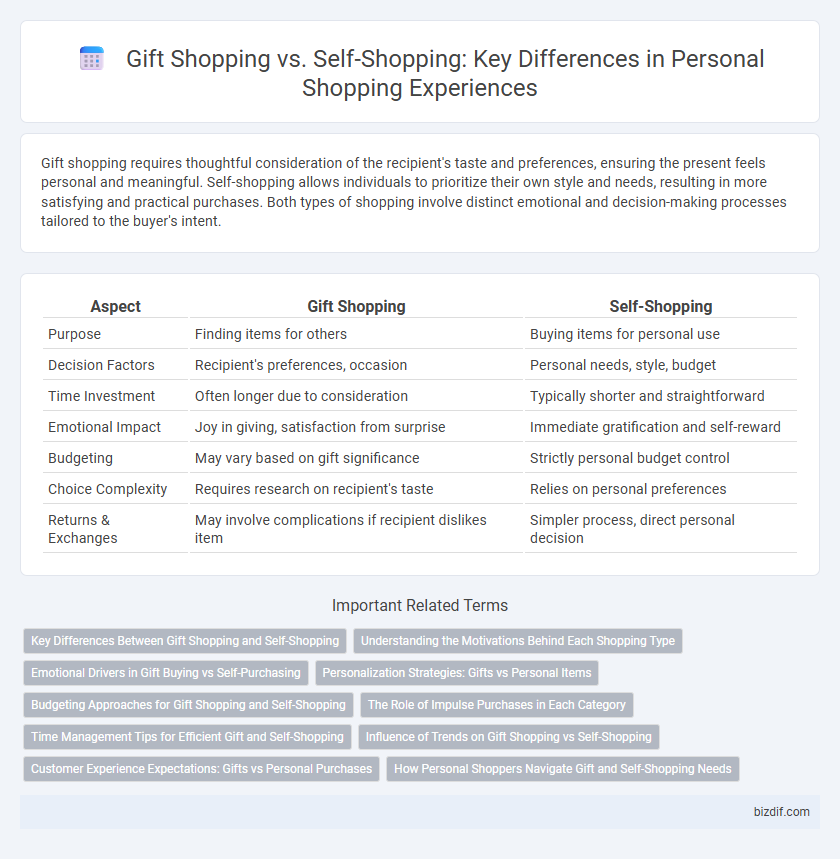Gift shopping requires thoughtful consideration of the recipient's taste and preferences, ensuring the present feels personal and meaningful. Self-shopping allows individuals to prioritize their own style and needs, resulting in more satisfying and practical purchases. Both types of shopping involve distinct emotional and decision-making processes tailored to the buyer's intent.
Table of Comparison
| Aspect | Gift Shopping | Self-Shopping |
|---|---|---|
| Purpose | Finding items for others | Buying items for personal use |
| Decision Factors | Recipient's preferences, occasion | Personal needs, style, budget |
| Time Investment | Often longer due to consideration | Typically shorter and straightforward |
| Emotional Impact | Joy in giving, satisfaction from surprise | Immediate gratification and self-reward |
| Budgeting | May vary based on gift significance | Strictly personal budget control |
| Choice Complexity | Requires research on recipient's taste | Relies on personal preferences |
| Returns & Exchanges | May involve complications if recipient dislikes item | Simpler process, direct personal decision |
Key Differences Between Gift Shopping and Self-Shopping
Gift shopping involves selecting items based on the recipient's preferences, requiring thoughtful consideration of their tastes, occasions, and needs, whereas self-shopping centers on personal desires and individual style. Budgeting strategies differ as gift shoppers tend to allocate funds for multiple recipients, while self-shoppers prioritize items that bring them personal satisfaction or utility. Emotional factors also vary: gift shopping often aims to convey affection or appreciation, contrasting with self-shopping's focus on self-expression and personal reward.
Understanding the Motivations Behind Each Shopping Type
Gift shopping often centers on selecting meaningful and personalized items tailored to the recipient's preferences, driven by emotional connections and the desire to convey appreciation or celebration. Self-shopping focuses on individual needs, comfort, and personal style, motivated by self-care, practicality, or indulgence. Understanding these motivations helps retailers tailor marketing strategies and product offerings to meet the distinct demands of each shopping type.
Emotional Drivers in Gift Buying vs Self-Purchasing
Gift shopping is often driven by the desire to express affection, gratitude, or social connection, making emotional considerations like thoughtfulness and the recipient's happiness paramount. In contrast, self-shopping tends to focus more on personal satisfaction, comfort, and individual preferences, reflecting a direct emotional reward through self-indulgence or fulfillment. Understanding these emotional drivers helps retailers tailor experiences that resonate with consumers' motivations during gift buying versus self-purchasing.
Personalization Strategies: Gifts vs Personal Items
Gift shopping prioritizes personalization strategies that emphasize the recipient's preferences, interests, and sentimental value, often incorporating customization options such as monograms, tailored packaging, or experiential gifts. Self-shopping focuses on individual needs and lifestyle, with personalization strategies centered on functional aspects, style preferences, and enhancing daily comfort or utility. Both approaches leverage data-driven insights and AI-powered recommendations to optimize the selection process, ensuring a meaningful and satisfying purchase experience.
Budgeting Approaches for Gift Shopping and Self-Shopping
Gift shopping often requires setting a pre-planned budget that balances the relationship with the recipient and the occasion, typically involving price comparisons to maximize value and avoid overspending. Self-shopping allows more flexible budgeting, focusing on personal priorities and preferences, which can lead to strategic spending on high-impact items or experiences. Both approaches benefit from tracking expenses and setting spending limits to ensure financial discipline and prevent impulse purchases.
The Role of Impulse Purchases in Each Category
Impulse purchases in gift shopping often stem from the desire to find unique or meaningful items quickly, leading to spontaneous choices influenced by seasonality and recipient preferences. In self-shopping, impulse buys typically reflect personal cravings or lifestyle upgrades, driven by emotional triggers and immediate gratification. Understanding these distinct motivations helps retailers tailor marketing strategies, optimizing product placement and promotions to capture impulse spending in both categories.
Time Management Tips for Efficient Gift and Self-Shopping
Efficient gift and self-shopping require strategic time management to balance careful selection with busy schedules. Prioritizing a well-organized shopping list and setting specific time blocks improve focus and reduce decision fatigue when browsing for gifts or personal items. Utilizing online tools and early planning further streamlines the process, ensuring timely purchases without last-minute stress.
Influence of Trends on Gift Shopping vs Self-Shopping
Gift shopping is heavily influenced by current trends as shoppers seek popular and culturally relevant items to impress recipients, often prioritizing novelty and social desirability. Self-shopping tends to balance trending products with personal preferences, where consumers are more selective and consider long-term usage rather than immediate popularity. The influence of trends on gift shopping drives demand for seasonal and limited-edition products, while self-shopping reflects a blend of trend adoption and individual lifestyle fit.
Customer Experience Expectations: Gifts vs Personal Purchases
Gift shopping demands a more personalized customer experience, with expectations for thoughtful product recommendations, premium gift-wrapping options, and timely delivery. Self-shopping often prioritizes convenience, ease of navigation, and detailed product information to support independent decision-making. Both experiences benefit from responsive customer support, but gift buyers typically seek added emotional and aesthetic value.
How Personal Shoppers Navigate Gift and Self-Shopping Needs
Personal shoppers tailor their approach by prioritizing the recipient's preferences, occasion, and budget during gift shopping, ensuring personalized and meaningful selections. In self-shopping, they focus on the client's style, lifestyle, and functional needs to curate wardrobe staples or trend items. This dual expertise allows personal shoppers to seamlessly balance emotional value with practical utility in their recommendations.
Gift shopping vs Self-shopping Infographic

 bizdif.com
bizdif.com